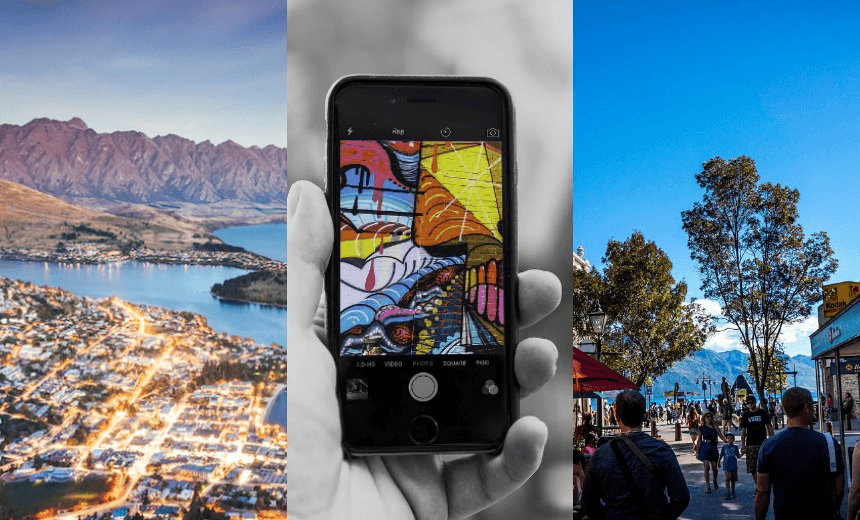The battle for New Zealand mobile network supremacy got a whole lot more interesting today, as Spark launched some cutting edge technology – in Queenstown. Peter Newport reports.
With a flick of a switch, Queenstown today became home to the fastest mobile data speeds in the country. The new 4.5 G mobile data technology, available in Queenstown CBD, Frankton, Arrowtown and some areas in between, will provide video and data streaming up to five times faster than the current 4G system.
But why Queenstown and not, say, Auckland?
The main reason is an explosion in data use. Just last month Queenstown chewed through 53 terabytes of mobile data and around half of that was video streaming. Tourists and locals can’t get enough data – so the infrastructure spend happened in Queenstown first, unlike virtually every other kind of infrastructure where Queenstown often comes towards the end of the line.
The other reason is earthquakes – or more accurately expected earthquakes. The Kaikoura earthquake late last year highlighted that if key sections of fibre optic cable get cut then the entire South Island can be disconnected.
So Spark has spent big bucks in a move that not only gives it a competitive advantage over the other mobile phone companies, but protects its network from the Big Alpine Quake which is expected any time soon. The Alpine Fault ruptures around one every 300 years …. and we are overdue for the next one.
By building a new fibre network in the South Island, with back up routes to protect places like Queenstown and Kaikoura, the extra capacity has also allowed the roll out of 4.5 G.
It’s a hell of a shot across the bows of competitors because, unlike the Chorus-built fibre network which gets on-sold by multiple retail providers, this new mobile phone and data network is only for Spark customers.
Spark engineers have been rebuilding cell phone towers in the Queenstown area for the past 12 months, but the assumption locally was that it was to squeeze more bandwidth out of these cell towers for wireless connections that are designed to replace old-fashioned, copper-connected landlines. That was controversial because it ran the risk of squeezing existing mobile users, if not off the network then closer to the fringes of the network.
But today’s announcement explains what the work was all about. The new South Island optical network will allow Spark to target even small communities with super-fast mobile coverage. They did this recently for one town I’d driven though often but never knew the name of – Albury, near Fairlie. It’s so small that the population peaked at 200 in 1948 and the new Spark cell phone network there sits on top of a wooden pole and is about the size of a shoe box.
The new Queenstown 4.5G network is already speeding up 4G phones, but it’s going to take the next generation of smartphones to actually exploit the full speed capabilities. My iPhone 7 was getting around 75 megabytes per second (Mbps) download and 35Mbps upload this morning – a massive increase. But on some 4.5 G test devices used at today’s launch we were seeing 478Mbps download and 46Mbps upload speeds on the mobile network.
Spark’s South Island Manager Paul Deavoll is clearly excited by the launch. “It really does change the game,” he told me. “This new backbone gives us a network that not only provides the speed for 4.5G data, but it means that the network be in a stronger position to survive the effects of a big South Island earthquake wherever it hits.”
The commercial subtext to all this is an encouragement to the market to start finding even more data-hungry applications for high speed, high capacity connectivity. Deavoll sees this challenge being met in Queenstown by the adventure tourism industry using augmented and virtual reality as part of the experience they sell.
“It’s easy to imagine tourists wanting to explore the virtual side of Queenstown. Already video is a huge part of what they take away from Queenstown – and what they stream back to their friends and relatives – but it’s a short step from where we are now to a new virtual future where video can be mixed with other information to become a new type of experience.”
It makes sense, especially as video is one of the key ways that the big Queenstown tourism operators extract extra cash from the tourists. Take any sky dive or jet boat package – it’s the souvenir video that drives the profit margins. Being able to enhance that video product is going to be very attractive to those tourism operators, especially if visitors can start to stream 4K videos in real time to a viewer anywhere in the world.
Spark’s little bomshell in Queenstown today is likely to trigger its own series of earthquakes as competitors plan matching moves. Most importantly it might signal the start of a trend where big technology improvements, and infrastructure builds, don’t automatically get launched in our biggest city.
While The Spinoff has a commercial relationship with Spark, this article was submitted on spec by a contributor who writes regularly on Queenstown issues. It is not sponsored content.
The Society section is sponsored by AUT. As a contemporary university we’re focused on providing exceptional learning experiences, developing impactful research and forging strong industry partnerships. Start your university journey with us today.

